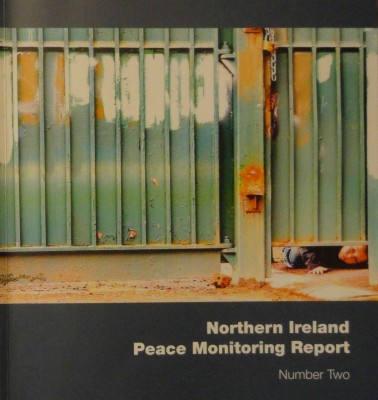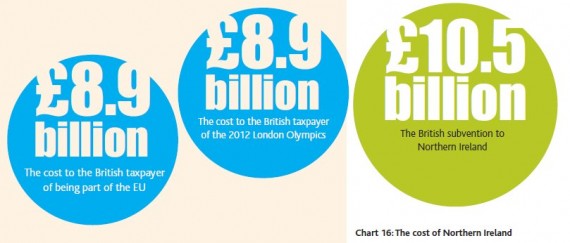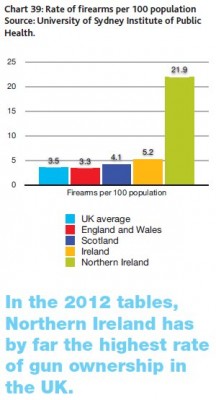The Community Relation Council’s second annual Peace Monitoring Report is launched this morning on the fifteenth anniversary of the signing of the Belfast Agreement. [Links to download sections from the report can be found in the CRC’s press release.]
 The report seeks to provide “a dispassionate analysis of the trends in Northern Ireland politics and society” in order to “look not only at the phenomena that break out on the surface but also at the less visible stresses within the society, the forces that drive politic on to the streets. It is the force field created by these competing pressures that permits or inhibits the emergence of a peaceful society”.
The report seeks to provide “a dispassionate analysis of the trends in Northern Ireland politics and society” in order to “look not only at the phenomena that break out on the surface but also at the less visible stresses within the society, the forces that drive politic on to the streets. It is the force field created by these competing pressures that permits or inhibits the emergence of a peaceful society”.
I spoke to the report’s author Paul Nolan earlier this week and he talked through some of this year’s main findings and conclusions.
As I noted last year, the 180 page report is “part statistical almanac and part annual narrative”, with an indicator framework of empirical measures used to assess year on year trends and changes – using the dimensions of security, equality, political progress as well as cohesion and sharing.
The majority of the figures collated by the report’s author Dr Paul Nolan are already publicly available. But together in the one document they tell the story of this place. [Liam Clarke had a piece on the report in Tuesday’s Belfast Telegraph – only one part of the article is currently online.]
The report draws out ten key points before delving into the detail.
The underlying momentum of the peace process was strong in 2012 … with household crime levels at a new low, hate crimes (including sectarian) reduced, the security situation allowing the G8 conference to be announced for Fermanagh, spoilt at the end of the year with the flag protests.
Northern Ireland is now a society made up of minorities … with national identity split across British, Northern Irish, Irish and other categories.
There is increasing ease with difference … the number of foreign nationals living in NI has risen to 11% of the population; evidence of recent migrants choosing to settle and raise their families in NI; and homophobic crime has dropped while there is increasing respect for the LGBT community.
The Assembly has faltered as a legislative chamber … “the legislative programme, which had increased in tempo in 2011, faltered in 2012 when only five bills were enacted”.
The real debates on national identity and sovereignty are taking place elsewhere … a referendum on Scottish independence has now been scheduled; the Conservative Party have pledged to hold a referendum on EU membership; while the Republic of Ireland “has been pulled tighter into a centralising EU”.
The fragility of the peace process has increased because of the continuing absence of a policy on division … there is an “impasse” over the Cohesion Sharing and Integration document, and no agreed strategy for flags, parades or dealing with the past.
Some paramilitaries have been marginalised, others have been granted a degree of legitimation … the murder of prison officer David Black is evidence of the continued paramilitarism threat from dissident republicans, yet the Great Britain threat level was reduced in October; meanwhile “loyalist paramilitaries have been granted a degree of recognition by their stewardship of their communities during the flags protest”.
The flag dispute has exposed the alienation of section of working-class loyalism … and notably, while 2010-2011 dissident republicanism action led to “strong public displays of solidarity by the political leadership of all parties”, “this was noticeably absent during the flags dispute”.
There has been a decline of residential segregation and an expansion of shared space … the 2001 census showed that 50% of council wards were single identity (ie, more than 80% of population from one communal background) while in the 2011 census the same measure had dropped to 37%.
Inequality gaps persist but are perceived differently … deprivation indices still show that Catholics experience considerable more socio-economic disadvantage than Protestants; 20% of Catholics aged 18-24 are unemployed as opposed to 15% of Protestants in that age range; Catholics “continue to enjoy greater educational success than Protestants”; overall though, looking at equality issues, the nationalist narrative “is of an upward trajectory”, while the unionist narrative “is one of loss”. Narrative speaks louder than facts. [A topic both Chris and I posted about in light of last year’s report.]
Some further statistics from the rest of the report:
- Northern Ireland (20.9%) like Wales (20.5%) lags four percentage points behind the rest of the UK (25.2%) in terms of 16-64 year olds with a degree (or equivalent qualification). And at the other end of the qualification spectrum, NI (18.3%) has nearly double the UK average (9.9%) of people in that age range with no educational qualifications.
- While it was good to hear Finance minister-elect Simon Hamilton speak (video / audio) about innovation at the recent TEDxStormont event, figures show that only 23 patents were applied for and granted from Northern Ireland in 2010 and 2011, compared with 148 in Wales, 316 in Yorkshire, 376 in Scotland, 783 in London and a further 1063 in the South East.
- In terms of being endowed with multi-millionaire, Belfast is proportionally banking way above its weight with 35.8 multi-millionaires per 100,000 population, third only to oil-rich Aberdeen (53.0) and London (51.6). Yet as a region, NI has the highest proportion of households with no savings accounts and the highest proportion of households deriving income from disability benefit.
- The “Wallace Park” council ward in Lisburn is the least deprived ward in NI. Whiterock in Belfast is the most deprived. Of the top 20 least deprived wards, four have switched between the 2001 census and the most recent 2011 census from being majority Protestant to being majority Catholic: “that the four new areas are all in Peter Robinson’s Castlereagh constituency is evidence of a remarkable demographic shift”!
 The annual British Treasury subvention to Northern Ireland (ie, the fiscal deficit between our public expenditure and Northern Ireland tax revenue collected) is £10.5 billion. That can be compared with the £8.9 billion it costs the UK to be part of the EU, and the £8.9 billion it cost UK taxpayers to host the 2012 London Olympics.
The annual British Treasury subvention to Northern Ireland (ie, the fiscal deficit between our public expenditure and Northern Ireland tax revenue collected) is £10.5 billion. That can be compared with the £8.9 billion it costs the UK to be part of the EU, and the £8.9 billion it cost UK taxpayers to host the 2012 London Olympics. NI has 21.9 firearms per hundred population compared with the UK average of 3.5.
NI has 21.9 firearms per hundred population compared with the UK average of 3.5.- NI has one police officer per 252 people; England and Wales (418); Republic of Ireland (330); Scotland (301).
- Security wise, while there has been a rise in the number of bombings and shootings over the past three or four years, there has been a decline in number of deaths. For 2011, 2 security-related deaths, 11 agriculture-related, 59 road deaths and 289 suicides.
- The suicide statistics are stark and shocking. NI is the only region of the British Isles to have had a steady increase in suicide rate over the 2001-2011 period, a near doubling. Over the ten year period, the suicide rate amongst 45-59 year olds has nearly caught up with the more often reported 15-29 and 30-44 year old age brackets.
From page 160-164 there is the best timeline I’ve seen of the build up to the flags vote and the subsequent protests: an unemotional and factual account of the decision points and the scale of the protests.
If there’s one disappointment with this this second annual Peace Monitoring Report, it’s that the final section looking at political progress doesn’t analyse the shifting tectonic plates within unionism in terms of elected members and how the UUP’s loss of four MLAs (David McClarty before the 2011 election; David McNarry, John McCallister and Basil McCrea more recently) affects the role of the UUP as mark fifteen years since the signing of the Belfast Agreement and head into the next stage of the peace process. The slowly growing desire amongst some MLAs for a more formal structure of opposition within the chamber will might helpfully form part of the narrative of next year’s report looking at whether the Executive is sufficiently scrutinised and performs efficiently and effectively when compared with other governments across these islands.
However, it is a superb baseline of the state of the nation and a report that should feed into evidence-based policy-making as well as many a blog post over the coming months.
Alan Meban. Tweets as @alaninbelfast. Blogs about cinema and theatre over at Alan in Belfast. A freelancer who writes about, reports from, live-tweets and live-streams civic, academic and political events and conferences. He delivers social media training/coaching; produces podcasts and radio programmes; is a FactCheckNI director; a member of Ofcom’s Advisory Committee for Northern Ireland; and a member of the Corrymeela Community.
Discover more from Slugger O'Toole
Subscribe to get the latest posts to your email.


